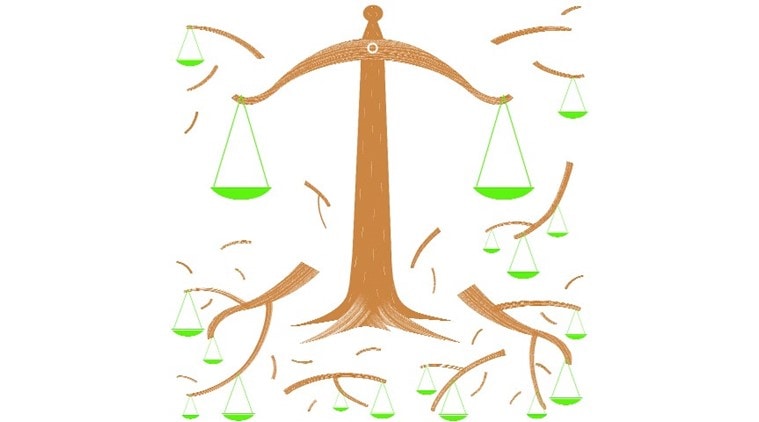A justice more efficient
The Legal Information Management and Briefing System aims to improve Union government’s handling of cases. Its data can also be used to reduce litigation, declog the judicial system.

LIMBS is meant to improve the Union government’s handling of cases. Illustration by C R Sasikumar
I have written about LIMBS in the past (‘Out on several LIMBS’, IE, August 24, 2017). LIMBS stands for Legal Information Management and Briefing System and is a Ministry of Law and Justice initiative. The idea is to reduce government litigation. Make government litigation more efficient, is a better statement. At the moment, this is about civil cases, though there is no reason why the idea can’t be extended to criminal cases. At the moment, this is about the Union government, though there is no reason why the idea can’t be extended to state governments. LIMBS is still a work in progress. Earlier, information about cases involving 64 ministries/departments was scattered in different places, typically in the form of physical files. That information is now available on a single platform, in electronic form. (I did say work in progress, therefore not every ministry/department is part of LIMBS yet.) In June 2017, 1,35,060 cases were part of LIMBS. That number is now 2,65,272.
This doesn’t mean the Union government’s proclivity towards litigating has suddenly shot up. It’s just that LIMBS coverage is increasing. Once data are available in this form, several questions can be asked. What types of cases are these? How old are they? What is the financial implication? Can cases be clubbed? Can some disputes be settled outside court? Why did the government lose a case? Those 2,65,272 cases are scattered across 2,107 courts and 15,332 advocates. Should more resources be devoted to certain courts? Is distribution of cases even across advocates? What is the track record of specific advocates?
LIMBS is meant to improve the Union government’s handling of cases. Its purpose isn’t that of facilitating research and/or reportage. Some data will no doubt be in the public domain, but not everything. An advocate, an arbitrator, or a new user from a ministry/department can log in. “Ministry’s designated nodal officer authenticates the user’s credentials and only authenticated users are allowed to access the website and enter the case details.” Perhaps I should add another quote. “To deal with contempt cases, LIMBS assigns highest priority to such cases which may cause unfavourable conditions for higher officials… SMS prompts are sent to concerned officials for a timely action.” Most cases, and most contempt cases, are against the Railways. Where are these cases? I will give rough orders of magnitude — 92,000 in tribunals, 71,000 in high court, 22,500 in Supreme Court, 13,000 in district and sessions courts and 8,000 in civil courts. What types of cases are these? 48,000 service matters, 39,000 writ petitions, 24,000 labour matters and 10,000 commercial matters.
An estimated 1,46,000 are ongoing cases, 17,000 are appeals and 14,000 are affidavits. About 1,03,000 cases have no financial implication, 20,000 less than Rs 1 lakh, 68,500 between Rs 1 and 20 lakh, 15,000 between Rs 20 lakh and 2 crore, 3,800 between Rs 2 to 100 crore and 190 more than Rs 100 crore. About 32,500 cases have been pending for more than 10 years, 58,000 for between 5 and 10 years, 50,000 for between 3 and 5 years, 82,000 for between 1 and 3 years and 4,500 for less than a year. Since there isn’t open access, not yet, you will have to accept my word about the veracity of these numbers.
The then prime minister addressed a Conference of Chief Ministers and Chief Justices in September 2004. “One way of reducing the load on courts is to reduce the quantum of cases that come to the courts. A sample survey conducted in Karnataka found that in 65 per cent of civil cases, the government was a litigant, sometimes on both sides. Government litigation crowds out the private citizen from the court system. Much of this government litigation is in the form of appeals and this survey again found that 95 per cent of government appeals fail. In a way, they are appeals that shouldn’t have been made in the first place. In 1994, the government had convened a meeting of law ministers and law secretaries that had resolved that, “disputes between the government and public sector undertakings (PSUs), and one PSU and another PSU ought not to go to courts or tribunals, and that such disputes should be settled between the parties amicably.” This, unfortunately, has not happened. The government will now ensure that this decision is effectively implemented.
This step, along with a better assessment of which judgments are to be appealed against, would lead to some reduction of cases in courts.” The speech didn’t mention the year (it was 1993) when National Law School of India University undertook this survey for Karnataka, nor the fact that the survey was restricted to Karnataka High Court alone. Those numbers, dated as they are, need not be valid across courts. Since LIMBS is still a work in progress, anything based on these numbers is tentative. But the rate of failure for government appeals is more like 45 per cent, not 95 per cent.
Technology for LIMBS didn’t exist in 1994, though it existed in 2004. Nevertheless, in 1994, one could have taken a decision preventing two government entities from litigating against each other. “This, unfortunately, has not happened.” In 2004, something like LIMBS could have been developed. “This, unfortunately, has not happened.” While this still represents early days, LIMBS has promise, from advocates getting paid on time to figuring out whether government should litigate (not just appeal). (In many instances, you can predict the outcome with reasonable certitude.) It also identifies petty cases the government can simply drop.
The writer is chairman, Economic Advisory Council to the PM. Views are personal
For all the latest Opinion News, download Indian Express App
More From Bibek Debroy
- Eighteen to sixty-fourEighteen to sixty-four should be the age range of the working population factored into policy, since enrolment in senior secondary school is rising...
- The anatomy of equityDebate around terms of reference of the 15th Finance Commission ignores the evolution of constitutional mechanisms for devolution of public finance...
- The Great Indian Epic TrickIt is meaningless to seek clear and present evil in the Mahabharata, where every incident offers a conflict of dharma. There is no black or…








































No hay comentarios:
Publicar un comentario